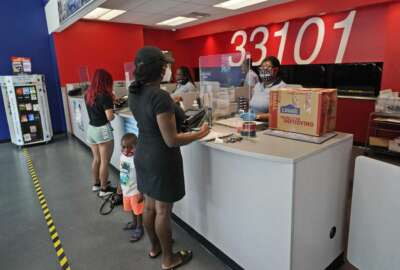The Postal Service is planning to expand its fingerprinting services to 4,000 facilities before the end of 2021 — a 40-fold increase from current levels – in an effort to make the most of its vast network of post offices across the country.
USPS awarded a contract Tuesday to IDEMIA National Security Solutions (NSS) to provide biometric capture and in-person proofing services.
The IDEMIA contract will build off the success of a pilot program USPS started with the FBI two years ago, which has led the agency to provide digital fingerprinting services at more than 100 post offices across the country.
The agency began offering its fingerprinting services to vet the 120,000 employees it hires annually.
Shane Powers, the vice president of operations at NSS, said the success of the program, and its potential for growth, stem from the agency’s vast delivery network. USPS operates 31,000 post offices, and 99% of the U.S. population lives within 10 miles of their nearest post office.
“The in-person proofing requires that in-person event, and so what better place to do that than a place that has facilities all over the United States — whether it’s many in some of the large-to-midsize cities or smaller offices in the smallest of towns. That’s what USPS sees as a great asset, a great way to generate revenue as well,” Powers said in an interview.
Before USPS digitized its fingerprinting process, local post offices and processing facilities required new hires to go through fingerprinting at nearby police stations, but processing those hard copy records took too long.
The emerging biometrics business at USPS doubles down on the agency’s reputation as much as its physical presence in most neighborhoods. Pew Research Center polls show that USPS continues to hold the highest favorability rating of any federal agency.
Powers said USPS is committed to preserving that trust by ensuring that it thoroughly vets new employees.
“They’re very proud that they’re one of the most trusted government agencies time and time again, and a lot of it comes back down to their employees,” Powers said. “This partnership will ensure that USPS employees are properly vetted through the FBI channels to make sure that they don’t have that rap sheet that has negative stuff in it.”
IDEMIA will also support USPS in offering digital fingerprint services, enabling faster turnaround from the FBI in providing members of the public with their criminal history records — officially referred to by law enforcement as an Identity History Summary Check.
Before its partnership with USPS, the FBI had up to a 14-week turnaround to process fingerprints, but local post offices have, in some cases, processed these fingerprints in less than a day.
Individuals go through the fingerprinting program if they apply for a visa, adopt a child or apply for jobs working with children.
Powers said USPS in its solicitation has considered offering these fingerprint services through a computer, tablet or kiosk, depending on the facility and the space available.
Customers will have to verify their identity before a USPS employee can assist them in submitting their fingerprints.
The push for biometric services stems from the latest USPS five-year strategic plan, which outlines five strategic goals:
- Goal 1 — Deliver world-class services and customer experiences
- Goal 2 — Equip, connect, engage, and empower employees to serve our customers
- Goal 3 — Innovate faster to deliver value
- Goal 4 — Invest in future platforms
- Goal 5 — Pursue legislative and regulatory changes necessary to achieve financial sustainability
Powers said USPS is looking at scaling up its biometric services to delivers on its strategic plan.
“They want to innovate faster, and with that comes this value that they’ll deliver. Our platform will be able to scale, it has the flexibility to deploy nationwide and very quickly, so we can move at the speed that USPS wants to innovate,” he said.
The nascent biometrics program at USPS has gotten off the ground faster than another proposed source of revenue — giving the agency the authority to conduct minor banking functions, like cashing checks and offering loans.
Sens. Bernie Sanders (D-Vt.) and Kirsten Gillibrand (D-N.Y.) introduced legislation in recent years that would authorize postal banking, and Reps. Bill Pascrell (D-N.J.) and Alexandria Ocasio-Cortez (D-N.Y.) supported the concept in a 2019 letter to USPS.
The agency already offers limited financial services, such as money orders and electronic funds transfers.
USPS hasn’t projected how much revenue it expects to bring in from its biometrics program, or whether it would move the needle on its long-term financial challenges.
The Postal Service ended fiscal 2020 with a $9.2 billion net loss, its 14th consecutive year in the red, despite a historic volume of election mail and packages during the COVID-19 pandemic.
Postmaster General Louis DeJoy has told Congress that USPS will embark on an ‘ambitious plan’ to cut delivery costs from its network, but the agency hasn’t publicly considered shuttering post offices – although has it looked at reducing post office hours.
“The reason that they continued it after the pilot is that they believe there’s a high return on investment for this type of transaction in this infrastructure, and it’s made to generate revenue and provide additional paths to sustainability for USPS,” Powers said.
Copyright
© 2024 Federal News Network. All rights reserved. This website is not intended for users located within the European Economic Area.
